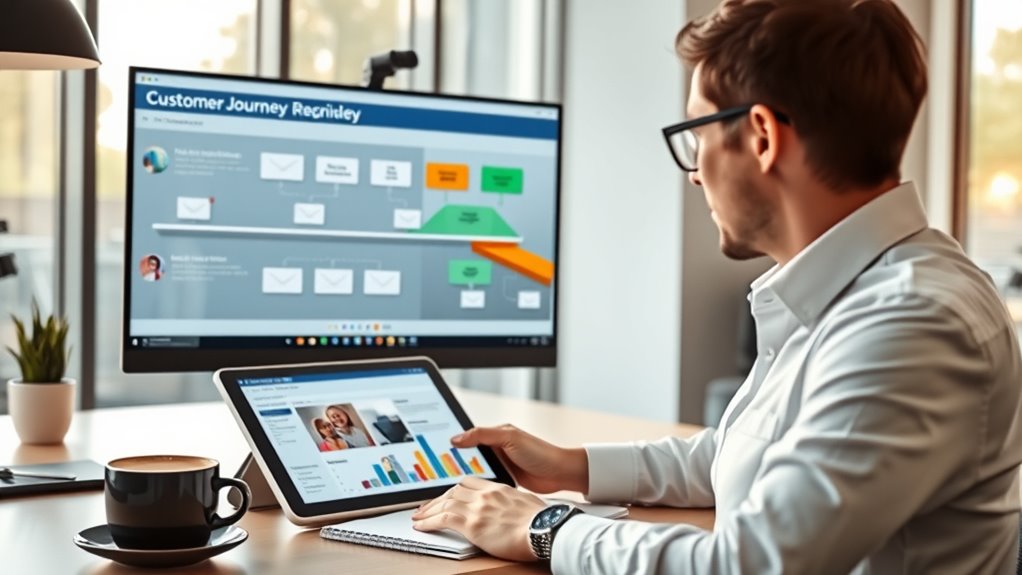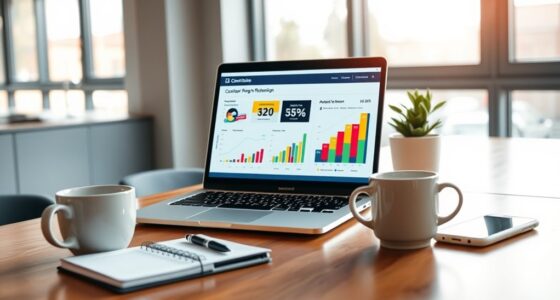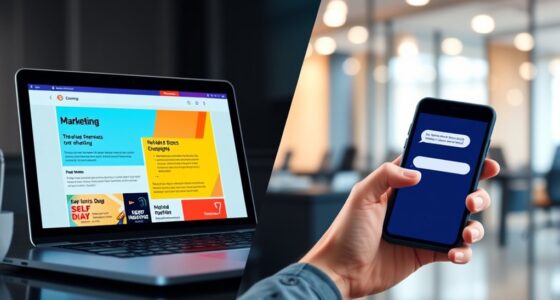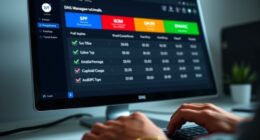Email marketing shines at every stage of your customer lifecycle by personalizing messages that build awareness, nurture relationships, and foster loyalty. In the awareness phase, targeted emails introduce your brand and promote first purchases. Post-purchase, it’s about strengthening bonds through tailored recommendations and exclusive offers. As customers become loyal, email helps reward their loyalty and encourage advocacy. Mastering these strategies can turn initial interactions into lifelong relationships; discover how to optimize each stage for lasting success.
Key Takeaways
- Email personalization enhances awareness and acquisition by targeting relevant offers based on browsing behavior and preferences.
- Post-purchase emails nurture relationships through personalized recommendations, exclusive offers, and automated engagement sequences.
- During retention, tailored content and rewards strengthen loyalty, encouraging repeat purchases and advocacy.
- Segmented email campaigns optimize messaging relevance at each stage, increasing engagement and conversion rates.
- Consistent, relevant email communication transforms first-time buyers into loyal brand advocates over time.

Have you ever wondered how businesses turn one-time buyers into loyal customers? The answer lies in effective customer lifecycle marketing, where email plays a pivotal role at every stage. To achieve this, you need to leverage personalization strategies that make your messages relevant and engaging. Personalization isn’t just about inserting a customer’s name; it’s about understanding their preferences, behaviors, and needs. This requires harnessing data analytics tools that provide insights into customer interactions, purchase history, and browsing habits. With these tools, you can segment your audience accurately and craft tailored email campaigns that resonate deeply with each recipient.
At the awareness and acquisition stage, your goal is to capture attention and encourage first-time interactions. Personalized emails here can introduce new customers to your brand in a way that feels relevant. For instance, if a customer browses a specific category but doesn’t purchase, an email featuring related products or special offers can nudge them toward making a first purchase. Data analytics tools help identify these browsing patterns, enabling you to send targeted messages that feel less generic and more like a personalized recommendation. This strategic use of data ensures your outreach isn’t wasted on irrelevant content, increasing the chances of conversion.
Once someone becomes a customer, the focus shifts to nurturing the relationship. Here, email campaigns should aim to increase engagement and foster loyalty. Using insights gathered from data analytics tools, you can send personalized follow-ups, product recommendations based on previous purchases, or exclusive offers that match their interests. For example, if a customer bought running shoes, you might send an email suggesting accessories or apparel to complement their purchase. Personalization strategies like these demonstrate that you understand and care about their preferences, building trust and encouraging repeat business. Automated email sequences can also be set up to welcome new customers, thank them for their purchase, and provide helpful tips or content, making them feel valued.
In the retention and advocacy stages, email continues to be a powerful tool. You can use data analytics to identify loyal customers and reward them with special discounts or early access to new products. Personalized content and offers make customers feel recognized and appreciated, fostering ongoing loyalty. Encouraging satisfied customers to share their experiences or refer friends can be seamlessly integrated into your email campaigns, turning happy clients into brand advocates. Additionally, understanding the growth and harvesting of chia seeds is an excellent example of how patience and consistent care can yield high rewards over time, similar to nurturing customer relationships. Throughout the entire customer lifecycle, the key is to combine personalization strategies with robust data analytics tools, ensuring your messaging remains relevant, timely, and impactful. This approach doesn’t just boost sales—it transforms one-time buyers into committed, loyal customers who advocate for your brand long-term.
Frequently Asked Questions
How Can I Personalize Emails for Different Customer Segments Effectively?
You can personalize emails effectively by implementing segmentation strategies that group your customers based on behaviors, preferences, or demographics. Use personalization techniques like dynamic content, tailored recommendations, and personalized subject lines to make each message relevant. Continuously analyze customer data to refine your segmentation and personalization efforts, ensuring your emails resonate with different segments and improve engagement. This approach helps you build stronger relationships and boost conversion rates.
What Metrics Best Measure Email Success at Each Lifecycle Stage?
You should track metrics like open rates and click-through rates to gauge engagement at each stage. Use segmentation strategies to tailor your content and A/B testing to optimize subject lines and calls-to-action. Conversion rates help measure how well your emails turn prospects into customers, while unsubscribe rates indicate relevance. Monitoring these metrics allows you to refine your strategies, ensuring your email campaigns effectively support customer journey progression.
How Often Should I Send Emails During the Customer Journey?
Timing is everything, so you should tailor your email frequency to customer engagement levels. Start with more frequent emails during the awareness and consideration stages, then gradually space them out as they move toward decision and loyalty. Keep a close eye on open and click-through rates to avoid overwhelming your audience. Remember, striking the right balance keeps your brand top of mind without turning customers off.
What Are Common Mistakes to Avoid in Lifecycle Email Marketing?
To avoid common mistakes in lifecycle email marketing, steer clear of segmentation pitfalls like overly broad groups or irrelevant messaging, which can frustrate recipients. Also, watch out for automation errors, such as sending too many or poorly timed emails, that can annoy your audience. Regularly review your segmentation and automation workflows, ensuring they align with customer behaviors and preferences, so your emails feel personalized and helpful instead of spammy.
How Do I Re-Engage Inactive Customers Through Email Campaigns?
You can re-engage inactive customers by sending targeted win-back strategies that include re-engagement incentives like discounts or exclusive offers. Personalize your emails to remind them of your value and create a sense of urgency with limited-time deals. Use compelling subject lines and clear calls-to-action to encourage clicks. Tracking their responses helps refine your approach, ensuring your re-engagement efforts are effective and bring them back into the active customer lifecycle.
Conclusion
Remember, every stage of the customer journey offers unique opportunities to connect and convert. By tailoring your email strategies to each phase, you’ll build stronger relationships and foster loyalty. Don’t forget the saying, “A chain is only as strong as its weakest link.” Stay consistent, be genuine, and adapt your approach as your customers evolve. When you do, email becomes your most powerful tool in guiding prospects from first contact to loyal advocate.







